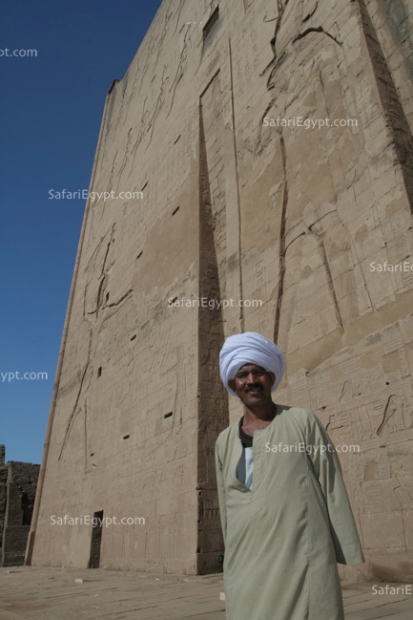|
Temple of Horus at
Edfu: Egypt's largest, best preserved Ptolemaic temple:
Buried under slit and sand for nearly two thousand years, the Temple
of Horus; dedicated to the Falcon headed God at Edfu, stands grand
to leave visitors gazing in wonder at architecture's gripping brilliance
and preservation's refined work. Reliefs from the temple account
that its construction began under Ptolemy III Euergetes in 237 BC,
taking 25 years of hard work to be completed. However, historians
believe that construction work continued up to the time of Ptolemy
XII.
Located at Edfu; exactly half-way between
Luxor and
Aswan, and accessible
to tourists, Horus's sandstone temple today is Egypt's best preserved,
and largest Ptolemic temple. So, whether you are visiting Luxor
or Aswan, check out daily organized visits to the temple available
in both cities, and make sure not to miss such a fascinating trip!
Horus: A Deeper Insight on Ancient
Egyptian Mythology:

One of the most universal Egyptian myths is that of Osiris and Isis.
Osiris was a beloved King who taught the Egyptians how to live,
worship, and cultivate. Jealousy drove his brother Seth to brutally
murder him, and scatter his body parts all over Egypt, as a sign
of victory and strength. Osiris's wife Isis gathered his body parts
with the help of other gods to create the first mummy in Egypt.
It was believed that Isis used her magical powers to resurrect her
husband, and hence conceived Horus to avenge his father. So, according
to Egyptian myths, Horus's temple is constructed on the sacred site
which witnessed the fierce battle Horus fought against his uncle
Seth.
Discovering the Temple :
The temple's Pylon: Once you get to the Temple's entrance, you'll
be struck by an imposing 36 feet high Pylon with reliefs depicting
Pharaoh Ptolemy XII defeating his enemies in front of Horus and
his beloved wife Hathor. You'll be also grandly greeted by two elegant,
black granite statues of Horus, adjoining the entrance.
Entering the temple (First Hypostyle Hall):
The two black, granite statues of Horus at the entrance will lead
you to a large colonnaded court, and the temple's first Hypostyle
Hall, which was discovered in the 1860s. The major highlight in
this hall is a matchless relief depicting the "Feast of Reunion";
of Horus and his beloved wife Hathor. As a beautiful symbol of spiritual
connection, Priests at Dendara Complex, where Hahtor's temple lies,
place her statue on her barque –every third month of summer-, and
send it to Edfu to re-unite her with her Husband Horus. It is also
recommended to visit the colonnade that has reliefs, retaining some
of its original color, depicting the birth of Harsomtus, son of
Horus and Hathor.
Sanctuary of Horus:
Behind the second Hypostyle hall lies the sanctuary of Horus known
for its black, granite shrine. Visitors are encouraged to tour the
surrounding chambers at a slow pace to soak up its magnificent reliefs,
making sure not to miss the relief of Hourus's sacred barque. Southwest
lies the remains of Horus's birth house, which was the focus of
the annual coronation festival, where Horus's birth was celebrated,
as well as his incarnation as the Pharaoh.
|
|

